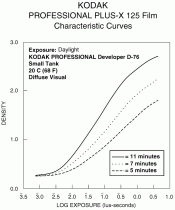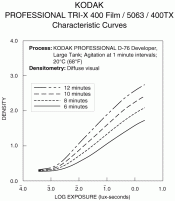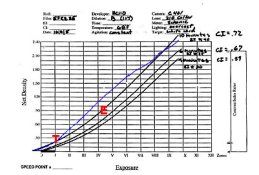smieglitz
Member
I recently ran a film test with Efke 25 sheet film exposed at EI 25 outdoors in open shade and developed in (US) HC110 dilution B for 4, 6, and 10 minutes. I plotted the curves and got the results indicated in the attached thumbnail.
It appears to me the film does have a daylight speed of about ISO 25 but I've never seen such a long-toed film curve. Excuse the geekness, but while I haven't actually shot a pictorial example yet, I'd expect this film to have little shadow contrast but striking contrast in the upper midtones and highlights. I'm thinking this film is akin to the old Kodak Plus-X and might be great for studio portraits. Is that a valid assessment?
Has anyone else plotted test curves for this film? (I've seen the curve on the J&C site using a different developer.) Any difference in the curve shape with different developers?
FWIW, it looks like I'd get my normal CI of around .62 at 4 3/4 minutes @68F in trays with constant agitation using HC110-B.
Joe
It appears to me the film does have a daylight speed of about ISO 25 but I've never seen such a long-toed film curve. Excuse the geekness, but while I haven't actually shot a pictorial example yet, I'd expect this film to have little shadow contrast but striking contrast in the upper midtones and highlights. I'm thinking this film is akin to the old Kodak Plus-X and might be great for studio portraits. Is that a valid assessment?
Has anyone else plotted test curves for this film? (I've seen the curve on the J&C site using a different developer.) Any difference in the curve shape with different developers?
FWIW, it looks like I'd get my normal CI of around .62 at 4 3/4 minutes @68F in trays with constant agitation using HC110-B.
Joe
Attachments
Last edited by a moderator:














